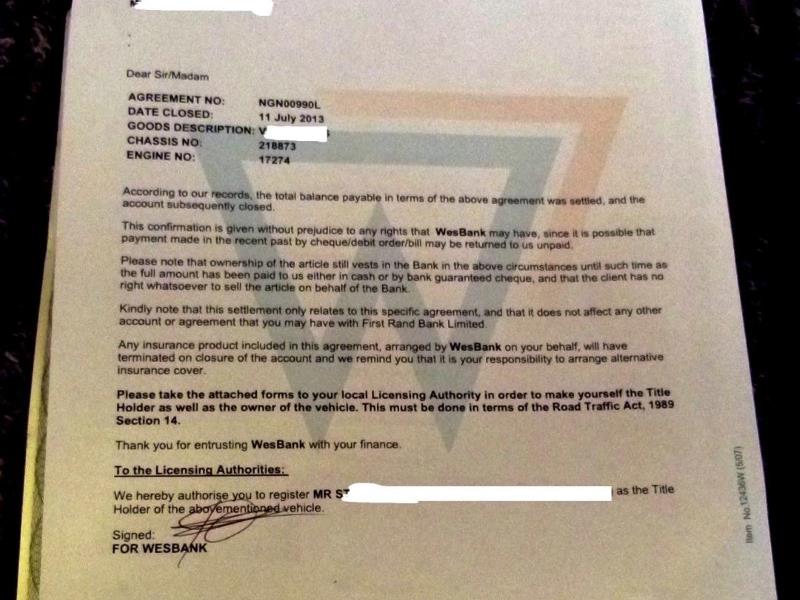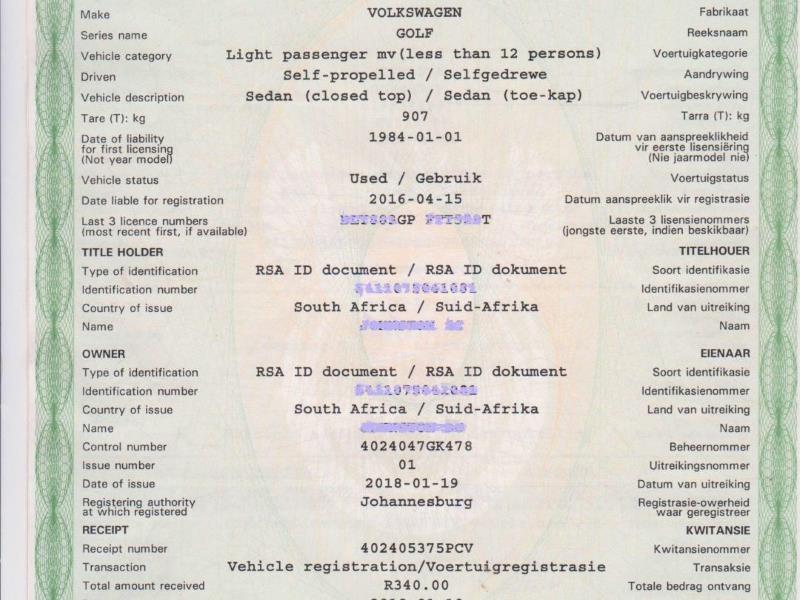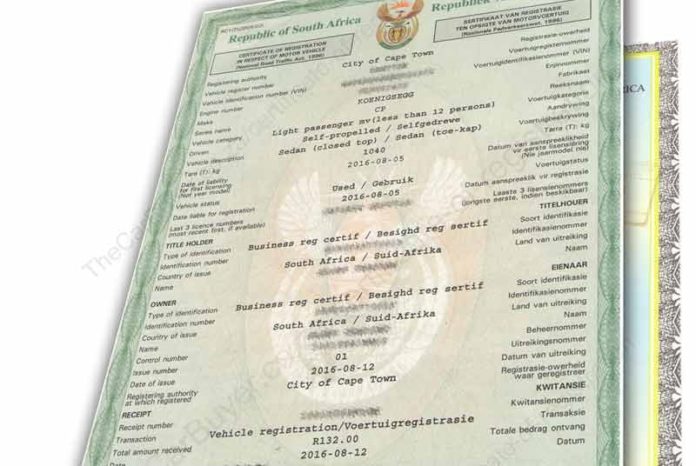National Traffic Information System (NaTIS) serves as a key resource in providing effective road traffic management. The national register helps to record, store, manage, and enforce the requirements of the National Road Traffic Regulations (NRTR) and the National Road Traffic Act (NRTA). Hence, the NaTIS document which is also known as the vehicle registration certificate, the Log Book, or Title Deed, is an official document that explicitly proves ownership of a vehicle. The document is mostly required when selling or buying a car.
In some other cases, when requesting police clearance, the vehicle registration certificate is also required and the document is sometimes requested by roadworthy centers, although all the information contained on the NaTIS document is also available on the license disk. Thus, the NaTIS document should be kept safe, so that when there’s a need for it, it will be readily available. But if lost, one can apply for a duplicate registration certificate, and here’s a guideline on how to obtain a NaTIS document, as well as the duplicate registration certificate.
How To Get a NaTIS Document
NaTIS document is issued to a car owner when his/her vehicle is registered at one of the traffic and licensing departments in SA. Prior to the implementation of a new licensing system in the year 1996, car owners used to be in possession of vehicle registration documents after the registration of the car, whether the purchase was financed by a bank or any other financial institution or not. Due to increase in fraud, the new licensing system was implemented and the financial institutions (referred to as titleholders) that finance the purchase of the vehicle get to keep the NaTIS document until the owner of the car pays off the loan and then applies for change of ownership to become the owner and titleholder of the vehicle.
So, an owner and titleholder can get a NaTIS document for a new vehicle by following these steps:
STEP 1: Go to the nearest vehicle registration authority and submit the following particulars:
- Identity document (ID)
- Manufacturer’s certificate of the vehicle which shows all of its relevant details.
- A roadworthiness certificate is required for heavy-duty vehicles or Road Transport Quality System (RTQS) vehicles.
- Evidence of residential address, for instance, a utility account. If the utility bill doesn’t bear the name of the owner of the vehicle, then the person whose name is on the bill should make an affidavit and declare that the owner lives at the address. The affidavit must be attached to the utility bill.
- A letter with an official date stamp from the ward councilor that confirms the residential address of the car owner. This is required when the person resides in an informal settlement.
STEP 2: The application form for Registration and Licensing of Motor Vehicle (RLV) should be filled and submitted. Then a NaTIS document will be issued to the car owner/titleholder.
If you are not the titleholder and have paid off the financial institution, and settled your account, you can obtain a NaTIS document as the titleholder of the vehicle by;
- Requesting for the NaTIS document from the bank or any other financial institutions that serve as the current titleholder of the vehicle.
- Visit the closest traffic and licensing department (motor vehicle registration authority) within 21 days the NaTIS document was received from the current titleholder and submit the document along with identification document (ID), and proof of residence.
- Complete a Registration and Licensing of Motor Vehicle (RVL) form.
- Pay a charged fee that varies from province to province.
- The amended NaTIS document will be issued to you, indicating that you are the owner and titleholder.

Registrations For Other Types of Vehicle Beside New Ones
There are four different vehicle statuses which include New, Used, Rebuild, and Scrapped. Thus, different registrations are available for these vehicles.
Steps Involved in the Registration of Pre-owned (Used) Vehicle
STEP 1: Submission of a filled Notification of Change of Ownership (NCO) form by the seller to the traffic and licensing department.
STEP 2: The buyer of the vehicle will go to the nearest vehicle registration authority and submit the following documents:
- Identity document (ID).
- Proof of purchase of the vehicle.
- A roadworthiness certificate is required when the current certificate is older than sixty days.
- Vehicle registration certificate that bears the name of the seller.
- Evidence of residential address, for instance, a utility account. If the utility bill doesn’t bear the name of the owner of the vehicle, then the person whose name is on the bill should make an affidavit and declare that the owner lives at the address. The affidavit must be attached to the utility bill.
- A letter with an official date stamp from the ward councilor that confirms the residential address of the car owner. This is required when the person resides in an informal settlement.
- A motor license that is valid. The license fees for the vehicle should be up to date.
STEP 3: Filling and submission of the application form for Registration and Licensing of Motor Vehicle (RLV). Then a NaTIS document will be issued to the buyer.
Steps To Register a Rebuilt Vehicle
STEP 1: For registration of a vehicle built up from parts, go to the nearest vehicle registration authority and submit the following documents:
- Identity document (ID)
- Evidence of residential address, for instance, a utility account. If the utility bill doesn’t bear the name of the owner of the vehicle, then the person whose name is on the bill should make an affidavit and declare that the owner lives at the address. The affidavit must be attached to the utility bill.
- A letter with an official date stamp from the ward councilor that confirms the residential address of the car owner. This is required when the person resides in an informal settlement.
- RPC form (request for police clearance).
- Affidavit that confirms where the parts of the vehicle were sourced from and what happened to the vehicle.
- RPI form (request for police identification)
- Weighbridge (mass measuring) certificate.
- Proof of title ownership.
- A de-registration certificate is required if the vehicle was deregistered.
STEP 2: The vehicle record will be introduced on eNaTIS by the provincial registration authority helpdesk.
STEP 3: Filling and submission of the Registration and Licensing of Motor Vehicle form (RLV), followed by issuing of a NaTIS document.

Can NaTIS Document Be Obtained Completely Online?
Oftentimes people ask whether the vehicle registration certificate can be completely obtained online. Well, the NaTIS document is only issued at the relevant motor vehicle registration authority. However, the application form for a certificate in respect of Motor Vehicle (Form ACV) can be downloaded on the eNaTIS website, filled, and submitted to the vehicle registration authority nearest to you. Aside from the aforementioned form, many other application forms can be downloaded on the eNatis website. They include an application form for Duplicate Registration or Deregistration Certificate in respect of Motor Vehicle (Form DRC), an application form for Deregistration Of Vehicle (Form ADV), and an application form for Driving License (Form DLI).
Additionally, on NaTIS online booking portal (online.natis.gov.za), a vehicle owner can register an online profile that captures his/her contact details in order to be receiving electronic communication from the National Traffic Information System. For instance, a car owner with a registered profile on NaTIS online booking portal receives notice for motor vehicle renewal two months before the expiration of the vehicle license. As such, the person can go to the nearest NaTIS service center and renew his/her license.
Also on the portal, one can make bookings to apply for a Driving License and/or Professional Driving Permits, as well as Learner License without vising traffic departments. You can also make reports for motor vehicle crashes on the NaTIS online booking portal. But for you to have access to the services, you must be a member of the South African public and have the following:
- South African identity document.
- Foreign identity document.
- Business Register Number (BRN) or Traffic Register Number (TRN)
What Kind of Information Does The Motor Vehicle Registration Certificate Contain?
Every NaTIS document contains vital information that makes it unique, especially the control number that helps to indicate a cloned/fake NaTIS document when buying or selling a vehicle. Other information on the document include:
- Registering Authority
- Register Number: A vehicle’s register number is not the same as the license number. The register number is part of the NaTIS system and contains 7 characters e.g ACD345X. It doesn’t change over time even when the car has changed ownership multiple times.
- VIN Number: The VIN acronym stands for a Vehicle Identification Number. It can also be referred to as the chassis number of the vehicle which is designated by the manufacturer. It is a unique number that sometimes indicates the batch number of the car, the design, or the date it was assembled.
- Engine Number: Also designated by the car manufacturer, the engine number must correspond with the stamped number on the sub-assembly of the vehicle’s engine. If on any occasion the sub-assembly of the engine gets changed, the new engine number should be submitted to the traffic and licensing department so that it corresponds with the number on the NaTIS system, license disk, and vehicle registration certificate.
- Make: This refers to the car manufacturer.
- Series Name: The name of the car model which sometimes can be designated as UNKNOWN on the NaTIS document.
- Vehicle Category: This includes the seven different categories of a vehicle;
A – Motorcycle
B – Light passenger vehicle (carries less than twelve passengers)
C – Heavy passenger vehicle (carries over twelve passengers)
K – Light load vehicle
L – Heavy load vehicle
U – Special vehicle (a tractor or other industrial vehicle)
M – Heavy load vehicle that tows a trailer

- Driven: This indicates how the car moves on the road and the four categories of driven include self, trailer, semi-trailer, and trailer towed by a tractor.
- Tare: The tare weight of a car determines the cost of the vehicle license.
- Date of Liability For First Licensing: The date the vehicle was introduced for the first time to the NaTIS system.
- Vehicle Status: It includes New (Code 1), Used (Code 2), Rebuild (Code 3), and Scrapped.
- Date of Liability For Registration: The date the ownership of the vehicle took place. It can be determined by the date on the notification of change of ownership by the seller or the date on the settlement letter issued by the financial institution.
- Last 3 License Numbers.
- Control Number: A unique identification number that authenticates the validity of a NaTIS document.
- Name of the titleholder.
- Titleholder’s Type of Identification and Country of Issue: Either an RSA identity document, a business registration certificate, or a traffic register certificate.
- Titleholder’s Identification Number
- Owner’s Name
- Owner’s Type of Identification and Country of Issue
- Owner’s Identification Number
- Issue Number
- Date of Issue
- Receipt Number
- Method of Payment
- Date
- Total Amount Received
- Received By: Name of the teller that carried out the transaction.
How To Make Corrections To Any Mistake on a NaTIS Document
A mistake on the NaTIS document can easily be corrected if you are the titleholder of the vehicle. All you have to do is to visit the traffic and licensing department closest to you with your identity document (ID) and proof of residence. The mistake(s) will be corrected immediately on your NaTIS document.
How To Obtain a Duplicate Registration Certificate If The Original is Lost
Although car owners are always advised to make copies of their vehicle registration certificate and give it to their family members or close friends, many people still lose their NaTIS documents to fire, theft, and flood. Nevertheless, all hope is not lost as you can apply for a Duplicate Registration/Deregistration Certificate in respect to Motor Vehicle (Form DRC) and also fill the Declaration in respect of Lost Documents Form (DCT) at any motor vehicle registration authority. You can also download the DRC and DCT Forms on the eNaTIS website. Fill and submit them to the nearest vehicle registration authority.

Remember to go to the vehicle registration authority with your identity document (ID) and proof of residential address. It is worthy to note that the application for a duplicate vehicle registration certificate can only be made by titleholders. The cost for the duplicate certificate varies from province to province but in most regions, it costs R150. So, one should verify the correct pricing in their region before visiting the traffic and licensing department. More so, the duration for the collection of the duplicate vehicle registration certificate differs in many provinces. For instance, in Capetown, the duplicate NaTIS document can be obtained on the spot while in other provinces, it can take from four to six weeks.
If your car was financed by a bank or any other financial institution and you have paid them off and done a transfer of ownership before losing the registration certificate, you have to reach out to the financial institution again. This time, you’ll be charged for their services which might take a longer period to be completed. Request for all the four documents required for transfer of ownership. Also ask the bank/other financial institutions for a new settlement letter, because the old settlement letter was dated and signed and failure to apply for a change of ownership within 21 days the letter was dated attracts a heavy penalty.
